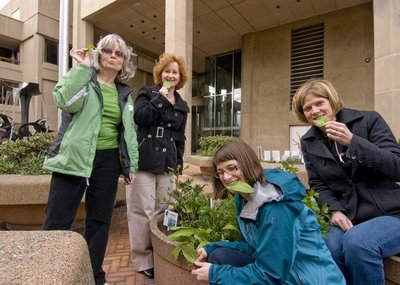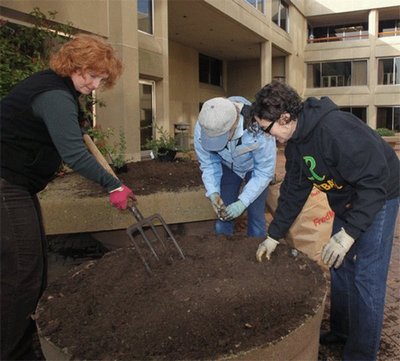March 4, 2010
UW Tower goes green with edible Patio Demonstration Garden
While students farm one-third of an acre on campus, inhabitants of the UW Tower are thinking even smaller. Their plots of land are measured in feet rather than acres, but they produce some crops that are just as appetizing. Say hello to the UW Tower Patio Demonstration Garden. In fact, you may already have seen it. It’s located on the brick plaza just south of the tower, in a series of concrete planters.
It all started when Cheryl Wheeler, the director of international specialized programs at Educational Outreach, was walking to work one morning last winter. She had been taking a gardening class, and she noticed that some of the planters on the patio were filled with ivy. “Ivy is invasive; it’s not a desirable plant,” she said. “I thought, ‘What if we did something edible here instead of ivy? Wouldn’t that be fun.’ So I went to talk to Bethany about it.”
Bethany is Bethany Staelens, assistant to Dave Szatmary, vice provost of Educational Outreach and Clark Westmoreland, the assistant vice provost and executive director of operations. Staelens, whom Wheeler credits with most of the energy behind pushing these projects through, was enthusiastic about the idea, as were Szatmary and Westmoreland. Wheeler and Staelens then talked to UW Tower Facility Manager Troy Swanson, who invited Grounds Manager Rod White to consult on the project. Wheeler next submitted a proposal to University Landscape Architect Kristine Kenney and it was approved.
That’s when Wheeler and a subcommittee of Educational Outreach’s “Green Team” got to work. The Green Team was founded by departmental staff back in 2008 to address office sustainability issues, and has since been extended to include other tenants of UW Tower. Wheeler gathered both experienced gardeners and enthusiastic inexperienced gardeners on the team to turn the patio green.
Once it was decided what to plant, it was a matter of getting rid of the ivy, carrying in bags of soil and compost and planting perennial shrubs and seeds. So far the group has planted rosemary, lavender, chives, thyme, edible daylilies, lingonberries, strawberries, huckleberries, salal berries, wintergreen, kale, broccoli, collards, Brussels sprouts, beets, carrots, flax and honeyberries.
Most of what they’ve planted is edible and low maintenance. “I chose things that were easy to plant, easy to take care of, things that would look good for at least three seasons,” Wheeler said.
In December, the group hosted a free lingonberry crepe party to celebrate the planting of their lingonberries and to raise awareness about the group.
They’ve also used some of the crops they’ve harvested for promotion. They held a “There is such a thing as a free lunch” contest to encourage people to become fans of their Facebook page, with the prize a three-course gourmet lunch prepared from the garden’s produce. Next up may be a strawberry ice cream party using some of the many strawberries currently growing in the planters.
Garden planting and maintenance generally take place on selected Sunday mornings. “Someone brings coffee, someone brings snacks,” Wheeler said. “It can be a big party with a lot of people, so the work goes really quickly.”
Over the last two Sundays, the group planted ceanothus, a popular pollinator attractant currently used on campus that has a striking purple flower; and a lesser known edible shrub called sea buckthorn, which has a bright orange berry that can be eaten fresh or made into a drink.
The group has labeled all the plants they’ve put into the planters so that visitors can identify what they’re seeing. Although the plants are in a public space, so far no one has tampered with them, Wheeler said. She has noticed that when people sit outside the building, they like to sit in the space where the new plantings are.
There are about 40 planters around UW Tower, and so far the group has placed plants in just 12. Some of the other planters already have attractive non-edible plants in them and won’t be touched, but Wheeler figures the group might eventually be working with 30 planters.
“The purpose of having this garden is not so much to produce a high volume of things to eat or to use, as on the UW farm, but to show people that it’s really easy to do this,” Wheeler said. “When you have useful things in your garden, it’s pretty enjoyable.”
Wheeler should know. Her master’s degree is in international environmental studies, and one of her favorite parts of graduate school was studying “wildcrafting,” which, among other things, means studying medicinal plants in different stages of development in the wild. She learned that if you take your time to choose certain plants that can take care of themselves, you can have a low maintenance garden. She’s used that knowledge in her own yard and is now extending it to her “yard” at work.
Szatmary and Westmoreland believe in this work enough that they have given the gardening group a small annual budget of about $500 to buy seeds, plants and other supplies. And they’re just one subcommittee on the Green Team. Other active subcommittees are:
- Paper Use Subcommittee: Formulated Educational Outreach guidelines addressing the use of resources (mainly paper, but also office supplies) and green meetings.
- Plastics Use Subcommittee: Formed to encourage the reduction and recycling of plastic packaging, the committee has placed bins in the Tower for recycling of plastic wrap, plastic bags and plastic bottle caps.
- Food Cycle Subcommittee: The committee has hosted film and guest speaker events for Tower residents on the benefits of local food production and consumption. It also arranged monthly delivery to the Tower of organic food and produce for subscribers to a community supported agriculture (CSA) program. The composting project has placed compost bins on each floor occupied by Educational Outreach. These bins are monitored and emptied by volunteers.
- Sustainable Audit Subcommittee: Plans to conduct an audit of the UW Tower and Educational Outreach in particular in terms of resource consumption.
Today the Green Team is 37 members strong, with 24 of those from Educational Outreach. They all have their motives for wanting to be part of the action, but for Wheeler it all comes down to those plants.
“Gardening is a big experiment,” she said. “You never really know what you’re going to get. Just the miracle of putting a little seed in the ground and something grows — it’s fascinating to watch that process.”




